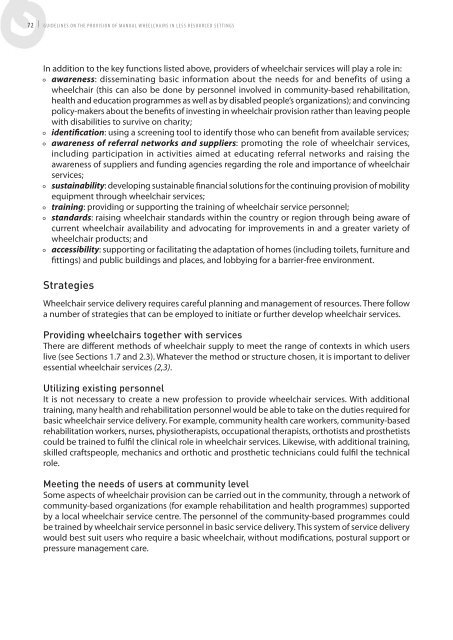Manual Wheelchairs - World Health Organization
Manual Wheelchairs - World Health Organization
Manual Wheelchairs - World Health Organization
You also want an ePaper? Increase the reach of your titles
YUMPU automatically turns print PDFs into web optimized ePapers that Google loves.
72 I guIdelInes on the provIsIon of manual wheelchaIrs In less resourced settIngs<br />
In addition to the key functions listed above, providers of wheelchair services will play a role in:<br />
• awareness: disseminating basic information about the needs for and benefits of using a<br />
wheelchair (this can also be done by personnel involved in community-based rehabilitation,<br />
health and education programmes as well as by disabled people’s organizations); and convincing<br />
policy-makers about the benefits of investing in wheelchair provision rather than leaving people<br />
with disabilities to survive on charity;<br />
• identification: using a screening tool to identify those who can benefit from available services;<br />
• awareness of referral networks and suppliers: promoting the role of wheelchair services,<br />
including participation in activities aimed at educating referral networks and raising the<br />
awareness of suppliers and funding agencies regarding the role and importance of wheelchair<br />
services;<br />
• sustainability: developing sustainable financial solutions for the continuing provision of mobility<br />
equipment through wheelchair services;<br />
• training: providing or supporting the training of wheelchair service personnel;<br />
• standards: raising wheelchair standards within the country or region through being aware of<br />
current wheelchair availability and advocating for improvements in and a greater variety of<br />
wheelchair products; and<br />
• accessibility: supporting or facilitating the adaptation of homes (including toilets, furniture and<br />
fittings) and public buildings and places, and lobbying for a barrier-free environment.<br />
Strategies<br />
Wheelchair service delivery requires careful planning and management of resources. There follow<br />
a number of strategies that can be employed to initiate or further develop wheelchair services.<br />
Providing wheelchairs together with services<br />
There are different methods of wheelchair supply to meet the range of contexts in which users<br />
live (see Sections 1.7 and 2.3). Whatever the method or structure chosen, it is important to deliver<br />
essential wheelchair services (2,3).<br />
Utilizing existing personnel<br />
It is not necessary to create a new profession to provide wheelchair services. With additional<br />
training, many health and rehabilitation personnel would be able to take on the duties required for<br />
basic wheelchair service delivery. For example, community health care workers, community-based<br />
rehabilitation workers, nurses, physiotherapists, occupational therapists, orthotists and prosthetists<br />
could be trained to fulfil the clinical role in wheelchair services. Likewise, with additional training,<br />
skilled craftspeople, mechanics and orthotic and prosthetic technicians could fulfil the technical<br />
role.<br />
Meeting the needs of users at community level<br />
Some aspects of wheelchair provision can be carried out in the community, through a network of<br />
community-based organizations (for example rehabilitation and health programmes) supported<br />
by a local wheelchair service centre. The personnel of the community-based programmes could<br />
be trained by wheelchair service personnel in basic service delivery. This system of service delivery<br />
would best suit users who require a basic wheelchair, without modifications, postural support or<br />
pressure management care.

















